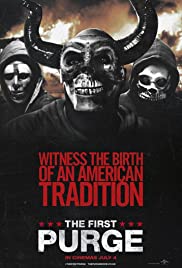
THE FIRST PURGE
US, 2018, 98 minutes, Colour.
Y'lan Noel, Lex Scott Davis, Joivan Wade, Mugga, Patch Darragh, Marisa Tomei.
Directed by Gerard Mc Murray.
In 2013, a comparatively small budget horror film made quite an impact, The Purge. It was written and directed by James De Monaco. He went on to make two sequels, capitalising on the impact of his original film. He has written the screenplay for this film – which is a prequel, going back to an experiment on Staten Island, sanctioned by the government, a night on which laws were relaxed and citizens could go about avenging crime. Some members of the public were interviewed by doctors and psychologists, concerned about anger management, and who agree, for money, to participate in the experiment.
The response to this version of The Purge by the public was very negative, very few favourable comments. And, compared with the other films, it is quite slight, exploitation of the theme, capitalising on the violence.
While De Monaco is a white American, the director, Gerard Mc Murray, is African American. If this film had appeared in the 1970s, it would have been called Blaxploitation. It dramatises racist attitudes, focusing on African- Americans with white Americans generally the villains. It would look as if it was appealing to an African- American audience and resentments against white Americans.
Audiences familiar with the original film is will remember that the purges are government organised and sponsored, a particular night in which there are no holds barred. This film opens with discontent in the United States, economic difficulties, civil rights. There are speeches by the president. The focus is very much on the local administrator and his scientific advisor (played by Marisa Tomei).
The film is rather small-focused insofar as the action takes place on one night in Staten Island, observed by media reporters, information televised throughout the United States, supervised by the man in charge and the doctor. He is unscrupulous. She begins to wonder what she has set in motion and leaves the surveillance only to be attacked outside the building and killed.
The film opens with a drug addict and his anger management, his face a kind of mask, intensely mad, happy to participate in the Purge, reappearing in the middle and attacking one of the young central characters who has been the victim of drug gang violence, but is seemingly killed. However, he is rather miraculously resuscitated the end and reappears, violently, to save the group.
This is an African- American world, ordinary citizens who gather in the church during the purge night, drug dealers and gang leaders. Eventually, the action focuses on the young man who has agreed to participate in purge night but then relents, his sister, some family and friends. They are pursued in the streets, take refuge in a high-rise building. One of the African- American leaders comes to the rescue, first of all an attack by white purgers dressed like the Ku Klux Klan, then military, masked, going through the high-rise building and massacring the tenants.
Final confrontations, violence, saving of the group, though the leader is wounded. Purge night ends and the group emerged to a cheering crowd.
More interesting in the conception rather than in the execution of the film.